To celebrate Spinneys’ 60-year anniversary in 2021, which coincides with the Golden Jubilee of the United Arab Emirates, Spinneys has created a cookbook that not only emphasises the role food can play in establishing part of a country’s culture but also its power to connect an ever-evolving and diverse community.
We asked 60 people, who live in the UAE, to each contribute a recipe, which speaks to their life in the Emirates. Within the book, you’ll meet loyal customers, staff members, home cooks, bakers, chefs, restaurateurs, bloggers and business people – all of whom were selected because of their love of cooking, their values, their close-knit relationship to Spinneys or the formative work they’ve done in the local F&B industry.
Here is a sneak peek into some stories that emerged during the making of this book.
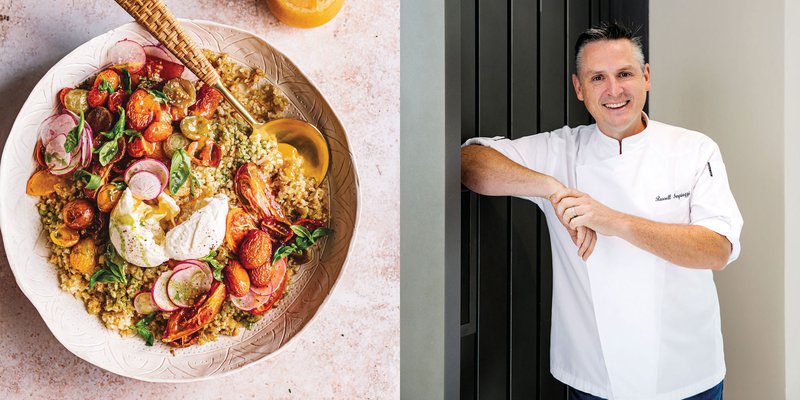
Burrata, heirloom tomato and freekeh salad by Russell Impiazzi, executive chef, Sofitel Dubai The Obelisk | British
Having worked his way up from an internship to sous chef positions in London, Russell was still only 19 when he got the call to join his friend and former executive chef, Schilo van Coevorden, who was running the signature kitchen of the Hyatt Regency Dubai. Faced with the choice of going down the Michelin-star restaurant route or going to Dubai, he chose the latter “to try it for six months”!
“I didn’t even know where Dubai was,” says Russell. Starting as the youngest chef at that hotel in 1996, he was at the Pyramids complex when it opened and executive chef there within six years. “I’ve spent most of my career in Dubai,” he says today, 25 years later. “With detours along the way.”
He’s a man who needs challenges and a tendency to accept intriguing offers led him away to join the pre-opening team of the Atlantis Bahamas Cove resort and to run the F&B offering of a Las Vegas entertainment group based in London. Then back to Dubai and again to Wafi before heading to help develop Galeries Lafayette as both a food hall and an events business.
When Covid hit in 2020 he was in London, trying to tame the “beast” that is Hilton’s massive Metropole Hotel. During the lockdown, he and his team catered to the overworked staff at St Mary’s Hospital next door and made use of the prevailing food surplus to supply more than 27,000 meals to people in need.
Russell returned to Dubai in early 2021 as executive chef for Sofitel Dubai The Obelisk, where his policy has been to fixate on the local and sustainable – minimal use of imported ingredients, maximal use of vegetables as a means toward a “plant-first diet”, across-the-board reduction of excess and waste.
With this in mind, his recipe for this book is based around freekeh, the grain he discovered in Dubai and carried around the world, introducing other chefs to its “smokiness and depth of flavour”. It also draws on tomatoes from his partners at Greenheart Organic Farms and burrata made fresh in the Emirates, “which would have been unthinkable even 10 years ago”.
“It’s a dinner party dish, it’s a barbecue dish, it’s a packed-lunch dish,” he says. “You can use this recipe as a base and go nuts with it.”
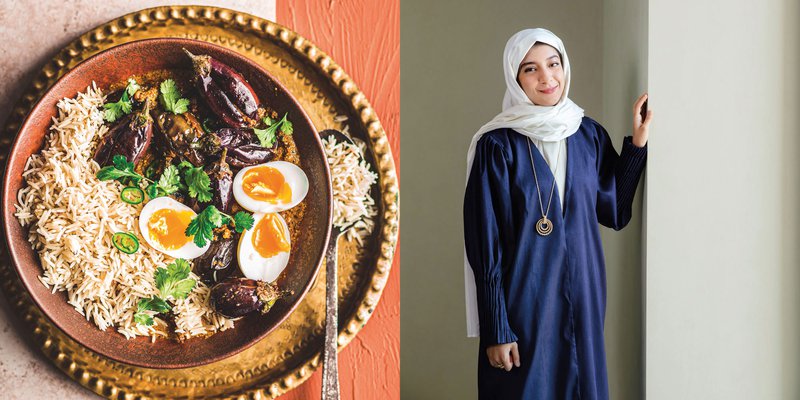
Bagara baingan (Hyderabadi aubergine curry) by Fatma Bin Jarsh, loyal customer and Instagrammer @fbinjarsh | Emirati
Listing off the things she loves, Fatma itemises (in no particular order): gardening, photography, graphic design, cooking on a daily basis and shopping at Spinneys.
“Mostly for vegetables and cheese. And chopped tomatoes,” she adds.
Born and raised in Dubai, she’s a recent graduate in tourism studies from the University of the UAE and lives at home with her parents and brother, where she does pretty much all the cooking.
“I enjoy preparing dishes from other cuisines,” says Fatma. “My brother has been trying various diets, so I’m also trying to focus on healthy recipes that aren’t boring.”
At the same time, she’ll use salt, black pepper and garlic in everything she cooks and her favourite cuisines are Iranian, Indian (vegetarian), Greek and Italian.
Her love of aubergine was enhanced by Mediterranean-style aubergine parmigiana, which bears some resemblance to the bagara baingan (Hyderabadi aubergine curry) that she shares with us here.
“It’s a dish with real value to my family,” she says, having inherited the recipe from her grandmother. “The base of it is coconut, sesame and peanuts, which you roast and blend together. My grandmother says it’s often served beside biryani, but I prefer it with flatbread.”
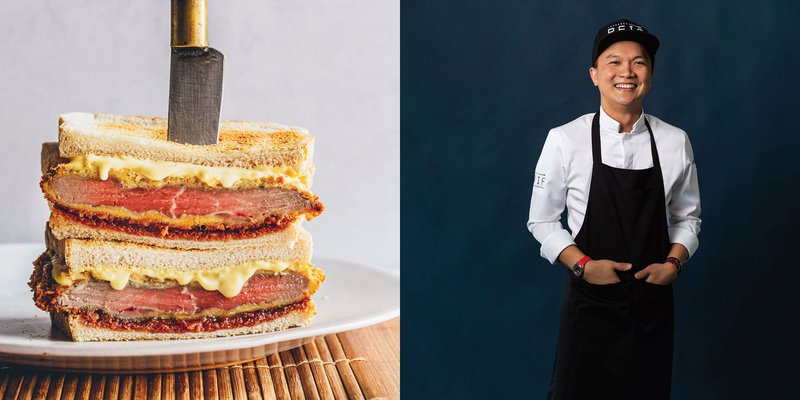
Wagyu katsu sando by Reif Othman, chef and restaurateur | Singaporean
Regular visitors to Dubai’s Japanese-inspired eatery Reif Japanese Kushiyaki can now cook its signature dish at home, as Reif himself shares the recipe for the monumental gourmet beef sandwich that he calls the Wagyu katsu sando.
“It’s been my top seller from day one and I’m proud of it,” he says.
Soon to be served at new branches in Cairo and Riyadh, the sando is emblematic of his successful approach to filling a vital gap between “high and low-quality food” – taking a humble Japanese snack and really making it his own.
Born in Singapore, he grew up helping his mother with the small food store she ran at a wet market.
“What really inspired me was seeing how raw fish and vegetables could be turned into a beautiful dish. Like the potato can be used in a thousand ways.”
Since first coming to Dubai to cook at the Burj Al Arab in 2004, Reif has jumped back and forth between various projects in the Gulf, Monaco and London, developing “techniques and philosophies” he picked up from his mentor, French chef David Mollicone. His tastebuds favour Japanese and Italian food, both relying as they do on “simplicity and quality”, though he’ll sometimes experiment with Middle-Eastern staples such as Moroccan-inspired lamb kushi skewers at Reif Japanese Kushiyaki, especially for Ramadan.
Reif’s home cooking is limited to preparing lunch boxes for his kids, who can be “very demanding”, he says.
A believer in fun, versatile cooking, Reif is now happy enough to give readers the fundamentals for putting their own spin on his mighty sandwich.
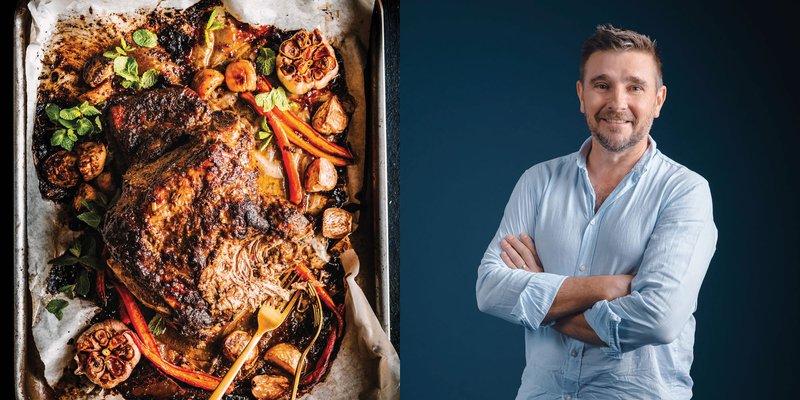
Slow-roast lamb shoulder with mint and cumin by Phil Durrell, loyal customer and director of Activities for RAK Leisure | British
One of Phil’s grandfathers was a chef in the British Army during the Second World War. The other was a major dairy farmer in the Essex countryside. So when he was growing up near East London, “it was always part of our culture to know where our food came from”.
“Family life revolved around the roast dinner on Sunday,” says Phil, though the recipe for slow-cooked lamb that he shares here is very different from the version that his mother still makes, having slowly absorbed several alternate flavours and seasonings from the UAE.
His first visit to the Middle East was in 1990, having taken a year out before university. He then joined the Royal Marines and abandoned his plan to study architecture to serve in the military for 12 years.
“I travelled the world, spent lots of time in Asia and Central and South America and experienced a lot of different food.”
As a civilian he has worked for various companies consulting on outdoor education and leading expeditions, relocating to Dubai in that capacity for six months that “turned into 16 years”. His current job at RAK Leisure involves helping to promote the Emirate as a destination for hiking, camping and other wilderness activities.
When not “playing in the mountains” as Phil puts it, he and his wife Lynne will often be hosting dinner guests. “We’re so lucky with all the foods we can try here and we can eat with a big group of friends from all over the world. We might go to someone’s house for biryani, and they might come to ours for a Sunday roast.” Everything on the table tends to come from Spinneys, where Phil “spends a lot of time”.
The fruit and veg are brilliant, especially with so much local produce coming through now. The staff are knowledgeable, so you can often ask the butcher for a cut that’s not on display. And there’s a wonderful cheese selection, which is a weakness of ours.”
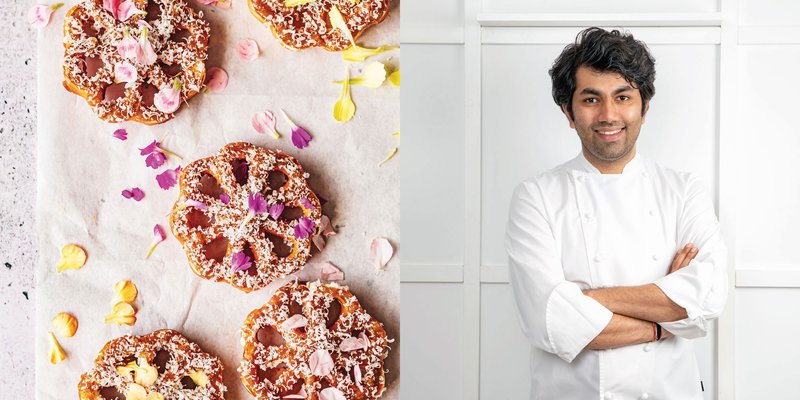
Indian Achappam with Parmesan ice cream by Himanshu Saini, executive chef at Trèsind Studio | Indian
Now one of Dubai’s most dynamic and celebrated chefs, Himanshu was never good at anything else. “Academically, I was an average student,” he says.
Having grown up in Old Delhi and always eaten well courtesy of his mother’s home cooking and the great street food available to him there, he took enough interest in food to qualify in hospitality and hotel management. Starting as an intern at the Delhi dining institution Indian Accent, he left five years later as a sous chef, moved to Mumbai in 2013 and opened a restaurant called Masala Library, which in turn became famous in short order. He came to the UAE in 2014 after a brief stint in New York, “which didn’t excite me”, he says, though Dubai didn’t either at first.
“I used to curse this city,” says Himanshu. “I’d ask myself why am I in this part of the world where nothing happens except for commerce, business and glamour. But I think it’s changing slowly and we are lucky to be part of that change.” He sees a new generation of chefs looking to build and expand on the local dining scene where so long ago, big international names would open restaurants in Dubai without actually basing themselves here.
His own imperative is entirely creative and his own enterprise at Trèsind Studio is a personal playground in that respect. “The menu changes every four months and we change the space too. The design, the music, all of that is just as important to me as what’s on the plate.” With a couple of exceptions, the dishes themselves are drawn from Gulf-sourced ingredients and often contain somewhere between four and 16 spices.
“The use of spice, the complexity of it and the way they are balanced, I think that’s what Indian food is all about. For us it’s natural, we grow up with these spices, but for Westerners it can be very surprising.”
The recipe he shares here indulges his personal fixation with Parmigiano Reggiano. That renowned Italian cheese, he explains, is often produced by Sikh farm workers – skilled emigrants from the Punjab.
“Indians know how to nurture dairy animals for the best results.” In this case, the cheese and its water are used to make an ice cream that’s then piped into a cookie. “It’s savoury, sweet, sour, salty and the cheese gives you that umami flavour too. The combination works.”
Buy this book in stores today!

